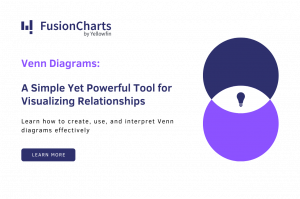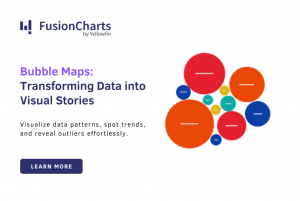Pie charts have been used, misused and abused. But what about the multi-level pie charts? They have been under-used, to put it simply. Other standard charts have been opted for even when the multi-level pie chart would have been the perfect fit.
So in this post of “Second Base with charts”, we will explore the multi-level pie chart and see how it can be used to effectively represent hierarchical data.
Table of Contents
What is a multi-level pie chart?
Multi-level pie charts are a set of concentric rings. The size of each item represents its contribution to the inner parent category. It starts with a single item that is put as a circle in the center. To see the breakup of that item, a concentric ring is set around the central circle. The concentric ring is then segmented to show how various child items have contributed to the parent item. To see the breakup of each of these child items, another concentric ring is set up. Since we want to see the breakup of the child items, the new ring will already be segmented the same way as the first ring. Within these segments, further segmentation is done to see the break-up of each of the child items in turn. And this process can continue till required. If you are feeling a little overwhelmed with the paragraph long explanation, sweat no further. We are going to take up a very easy example that will make things crystal-clear to you.A simple example
If you have ever used Adwords, you would have surely done some digging to see which ad group is giving you the most clicks. Using multi-level pie, it is pretty easy to find out what’s working for you and what’s not in Adwords. So let us take a look at the Adwords account for a company which we will conveniently call XYZ. Now XYZ makes websites for clients and promotes them too. Typically, they would like to run ads for web development, design and marketing. This is how their Adwords campaign would look:
Adwords distribution using multi-level pie chart
So this is how XYZ would like to analyze their Adwords account. Let’s analyze the multi-level pie step by step:- Since Adwords Clicks is what XYZ wants to analyze, it forms the central circle.
- XYZ runs separate campaigns for Design, Development and Marketing. So the concentric ring around Adwords Clicks is broken down into 3 segments. The size of each segment indicates how many leads that campaign has got for XYZ. Quite clearly, web design is what has been getting XYZ the most leads and Marketing the least. But just that much info wouldn’t equip XYZ to make solid business decisions. They would like to know what ad group under Design has been working so wonderfully well for them.
- So another concentric ring is formed. This ring as you can see is already segmented to show the primary classification – Design, Development and Marketing. For further sub-division of say Design, it will have to be done within the yellow segment itself of the ring.
Variants of the multi-level pie chart
In the Adwords example, the segments had various sizes to show how much of a parent item is constituted by a child item. But this need not always be the case. Multi-level pie charts can also have the same size for all the segments in a ring. Such a multi-level pie chart is called a symmetrical multi-level pie chart. It is used for displaying the hierarchy in an organization.
Organizational hierarchy using multi-level pie chart
Where can multi-level pie charts be used?
We just saw a couple of situations where a multi-level pie chart comes in really handy. But this is not all. In fact, any place where your data has a deep level of hierarchy, multi-level pie chart is the tool you are looking for.- Revenue breakdown: Let’s say you are an online travel agent. You make money by allowing people book flights, cars and hotels. Under this primary classification, you would be having secondary classifications – for example, for flights it will be economy, business and first class. This in turn can be broken down under the heads of various airlines. So you could make a multi-level pie chart depicting the revenue for various items. And then compare various items in it to see if the same effort is bringing in similar revenues for any 2 items in comparison. Otherwise, you would know where to bring about changes.
- Football Squad breakup: You are the manager of a high profile football club. If you want to view the resources under you, you can easily plot it on a multi-level pie chart. You can break down your squad into defenders, midfielders, forwards and goalkeepers. These positions can be further broken down into specific positions. For example, the forwards can be divided into left wingers, center forward and right wingers. And this can finally lead to the player names themselves. This will help you view your resources very clearly and make necessary transfer judgments to buy players you need or sell the ones you don’t.



Sanket (FusionCharts Team)
January 3, 2010, 8:15 pmOur product PowerCharts (https://www.fusioncharts.com/PowerCharts) offers multi-level pie charts – all the examples in the post have been created using it.
As for free utilities, I haven’t come across anything good till now.
Hashimoto
January 3, 2010, 7:17 pmWhat commercial software is available for making such multi-level pie charts? Is there any free online resources to make these?